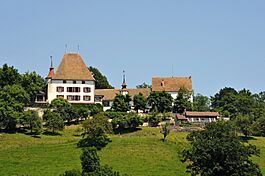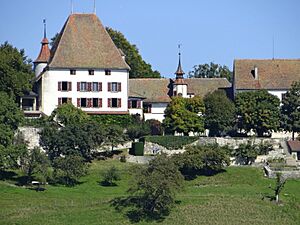Burgistein facts for kids
Quick facts for kids
Burgistein
|
||
|---|---|---|

Burgistein Castle
|
||
|
||
| Country | Switzerland | |
| Canton | Bern | |
| District | Thun | |
| Area | ||
| • Total | 7.52 km2 (2.90 sq mi) | |
| Elevation | 763 m (2,503 ft) | |
| Population
(Dec 2020 )
|
||
| • Total | 1,093 | |
| • Density | 145.35/km2 (376.4/sq mi) | |
| Postal code |
3664
|
|
| Surrounded by | Gurzelen, Kirchdorf, Lohnstorf, Noflen, Riggisberg, Rüti bei Riggisberg, Seftigen, Wattenwil | |
Burgistein is a small town, also called a municipality, located in the Canton of Bern in Switzerland. It's part of the Thun area. Burgistein is known for its historic castle and beautiful natural surroundings.
Contents
Exploring Burgistein's Past
Burgistein was first mentioned in old documents in 1266. Back then, it was called Burgstein.
Early Settlements and Castles
People have lived in this area for a very long time. Archeologists have found old tools from the Stone Age and even ancient Roman coins. In the early Middle Ages, there was a small fort on Bühlhölzli hill. Another castle, Blankenberg Castle, stood on Schönegg hill but was later taken down.
Building Burgistein Castle
In the 13th century, a man named Jordan I of Thun started buying land in the Gürbetal valley. Around 1260, he brought all these lands together to create a special territory called a Herrschaft, which means a land ruled by a lord. He then built Burgistein Castle. By 1266, he started calling himself Jordan von Burgistein, named after his new castle.
Castle's Challenges and New Owners
In 1340, Burgistein Castle was destroyed. This happened after a big battle where Burgistein had supported the losing side against the city of Bern. But don't worry, the castle was rebuilt just a few years later! Over the centuries, the castle had many different owners. In 1484, Jakob von Wattenwyl, a leader from Bern, bought it. His family owned the castle for over 200 years. The castle you see today was rebuilt in the 15th and 16th centuries.
Modern Changes in Burgistein
For a long time, Burgistein was mostly a farming community. But starting in the 1970s, it began to change. Many people who live in Burgistein now travel to work in bigger cities like Bern and Thun. This means it has become a "bedroom community."
Burgistein's Geography
Burgistein covers an area of about 7.5 square kilometers (about 2.9 square miles). A large part of this land, about 76%, is used for farming. Forests cover about 13% of the area. The rest of the land, about 9.7%, has buildings and roads.
Land Use and Natural Features
About 5.6% of the land is covered by houses and other buildings. Roads and transportation areas make up 3.5%. Most of the forested land is dense forest. A small part, 3.3%, is used for orchards where fruit trees grow. All the water in Burgistein comes from flowing rivers and streams.
Where People Live
Burgistein is not like a typical town with one main center. Instead, it's spread out with several smaller areas. The closest thing to a center is Burgistein-Dorf, which grew up around the old castle. The municipality also includes smaller villages or hamlets like Weier, Niederschönegg, Äbnit, and Plötsch. There are also newer areas like Burgistein-Station, which includes Grossmatt, Burgiwil, and Pfandersmatt.
Burgistein's Coat of Arms
The blazon of Burgistein's coat of arms shows a silver and black shield. On the silver part, there is a red deer jumping up.
People of Burgistein
Burgistein has a population of about 1,021 people. Most of the people living here are Swiss citizens.
Languages Spoken
Most people in Burgistein speak German. It is the first language for almost 98% of the population. A small number of people also speak English or French.
Age Groups
In Burgistein, about 22.7% of the population are children and teenagers (under 19 years old). Adults (20 to 64 years old) make up about 61.2% of the population. Seniors (over 64 years old) are about 16.1%.
Population Over Time
The chart below shows how the population of Burgistein has changed over many years.

Important Historical Sites
The Castle is a very important historical site in Switzerland. It is recognized as a national heritage site, meaning it's protected and valued for its history and culture.
Burgistein's Economy
In Burgistein, many people work in different jobs.
Types of Jobs
There are three main types of jobs:
- Primary sector: This includes jobs related to farming, like growing crops and raising animals. About 103 people work in this area.
- Secondary sector: These jobs involve making things, like in factories or construction. About 118 people work in this sector.
- Tertiary sector: These are service jobs, such as working in shops, hotels, or schools. About 98 people work in this sector.
Working and Commuting
Many people who live in Burgistein travel to other towns for work. About 143 people both live and work in Burgistein. Many people use their cars to get to work, while some use public transportation.
Religion in Burgistein
Most people in Burgistein belong to the Swiss Reformed Church. A smaller number are Roman Catholic. There are also people who follow other Christian faiths or other religions like Islam and Buddhism. Some people do not belong to any church.
Education in Burgistein
Switzerland has a good school system, and Burgistein is part of it.
School System Overview
Children in Burgistein usually start with one year of non-required Kindergarten. After that, they go to six years of Primary school. Then, they attend three years of lower Secondary school. In secondary school, students are placed into different groups based on their abilities. After lower Secondary, students can choose to continue their education at a university or a specialized college, or they can start an apprenticeship to learn a trade.
Students in Burgistein
During the 2011-2012 school year, about 97 students attended schools in Burgistein. There was one kindergarten class with 17 students. There were four primary classes with 67 students. There was also one lower secondary class with 13 students. Most of the students who go to school in Burgistein also live there.
See also
 In Spanish: Burgistein para niños
In Spanish: Burgistein para niños






